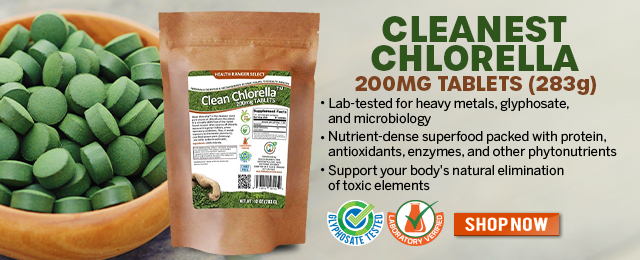
Newborn Procedures: Make an Informed Choice about the Vitamin K Injection
Friday, July 17, 2009 by: Jen Patterson
Tags: vitamin K, health news, Natural News
- Newly released JFK files reveal Pentagon's role in creating Lyme disease and covid in the same lab
- Dr. Suzanne Humphries makes bombshell appearance on Joe Rogan podcast, exposing vaccine industry deception back to POLIOMYELITIS
- L.A.'s rebuilding nightmare: Only 4 permits issued after fire destroys 6,000 homes
- Discovery of vast underground city beneath Giza pyramids challenges human history
- Black cumin seed oil emerges as a powerful ally against breast cancer and chronic inflammation
- “Independent” anti-Russia outlet MEDUZA faces COLLAPSE as US funding dries up
- Catastrophic 7.7 earthquake devastates Myanmar and Thailand; death toll could reach 100,000
- The hidden battle in your glass: How A1 and A2 milk could shape your health
- AI breakthrough slashes celiac disease diagnosis time from months to minutes
- BPA: The hidden hormone disruptor sabotaging your health - and how to fight back
- Sugar-free deception: Artificial sweeteners hijack hunger signals, fuel obesity epidemic, study warns
- Europe braces for WAR as EU urges citizens to STOCKPILE FOOD, in latest provocations with Russia
- Putin vows to 'finish off' Ukraine, accuses West of prolonging the war
- Thomas Massie’s Dual Loyalty Disclosure Act aims to restore American sovereignty by cracking down on foreign influence in Congress
- Aluminum pollution: A silent threat to human health
- Tesla owners under siege: Road rage, vandalism and political backlash fuel fear among drivers nationwide
- Chaos in Amsterdam: Five injured in broad daylight knife attack near Dam Square
- "Feel G.O.O.D. Gut Health Program" on BrightU: Dr. Basima Williams introduces the Feel-Good Plate Method
- Newly released JFK files reveal Pentagon's role in creating Lyme disease and covid in the same lab
- Analysis: The coming economic collapse, a mass uprising and Trump's three secret weapons to halt the growing revolt
- Festive flavors: The sweet history, nutritional profile and health benefits of pecan pie
- Elon Musk: Aliens could be here on Earth RIGHT NOW
- Trump reverses course on Gaza plan, says “nobody is expelling Palestinians”
- Big Pharma's $8 Billion bribery scheme exposed: how doctors are pushed to prescribe junk science, not heal
- Boys are back in town: Trump’s patriotic alpha crew takes the wheel while toxic females ride in the backseat
- Reclaim your health: How midlife exercise reverses years of inactivity
- A lack of integrity in Academia: Harvard professor found GUILTY of fraudulent research to promote CRT theory
- Survival 101: Effective EMF blocking techniques
- EPA advisor admits the agency is funneling billions to climate groups ahead of Trump’s return to White House
- Dr. Mike Yeadon releases 15-minute testimony - WATCH - about genocidal intent of COVID “vaccines”
- 5 Simple steps to boost your brainpower: How to strengthen executive function in a distracted world
- Florida takes a stand: DeSantis proposes permanent ban on mRNA vaccine mandates
- Sugarcane extract superior to cholesterol-lowering drugs?
- Mike Adams Sermon 66: God will DESTROY ISRAEL for its wickedness
- Pilots report mysterious lights 'moving at extreme speeds' across Oregon skies
- Space war brewing? Russia threatens to destroy Starlink satellites
- EPA advisor admits the agency is funneling billions to climate groups ahead of Trump’s return to White House
- California's social media censorship law struck down: A victory for free speech or a threat to online safety?
- The Health Ranger releases “Vaccine Zombie” song and music video, using AI-animated zombies for the music video
- Dr. Mike Yeadon releases 15-minute testimony - WATCH - about genocidal intent of COVID “vaccines”
- The pandemic as a tool for INDOCTRINATION: Understanding “The Indoctrinated Brain” by Dr. Michael Nehls
- Newly released JFK files reveal Pentagon's role in creating Lyme disease and covid in the same lab
- Florida takes a stand: DeSantis proposes permanent ban on mRNA vaccine mandates
- Mike Adams releases country western hit single: Goin’ Back in Time is Comin’ Home
- Mike Adams releases music poetry sensation: A Child of God
- “Why we influenced the 2020 elections”: Facebook files reveal the coordinated effort to bury the Hunter Biden laptop story
- Unpacking the Lies That We’ve Been Fed – new song and music video released by Mike Adams, the Health Ranger
- RFK Jr. clears key hurdle: Sen. Susan Collins backs controversial HHS nominee, signaling a new era for health policy
- Mike Adams releases new song and music video: Nothing More Disgusting Than a Globalist
- Michigan sheriff announces criminal investigation into 2020 election crimes, Dominion Voting Systems
- Israeli soldiers accused of even more torture and abuse in the West Bank
- Migrants are taking advantage of recent hurricanes to scam residents and loot their homes
- House Intelligence Committee calls for the ARREST and PROSECUTION of Dr. Anthony Fauci
- Rep. Nancy Mace introduces bill to ban biological males from female facilities on federal property
- Red Cross issues warning to stop blood plasma donations from vaccinated people
- Scientists confirm: GENIUS brain function can be spontaneously unleashed in humans without any apparent cause
- EPA advisor admits the agency is funneling billions to climate groups ahead of Trump’s return to White House
- HYSSOP: What research reveals about the health benefits of this ancient holy herb
- Two containers with completed ballots fall out of truck in Florida
- Fully vaccinated about to see “tsunami” of illness and death, warns virologist
- Global leaders unite to clamp down on “misinformation” with UN-backed Cascais Declaration
- BREAKING: 2025 NDAA authorizes mandatory military draft of WOMEN across America… as Pentagon pursues global NUCLEAR war with both Russia and China at the same time
- Michael Yon warns of a ZIONIST TAKEOVER in Trump’s second administration
- BOMBSHELL: DNA testing kits are a SCAM to develop ethnic-specific bioweapons
- Ozempic and Wegovy weight loss drugs are injectable LIZARD VENOM PEPTIDES that may unleash a devastating wave of organ failure… side effects align with symptoms of SNAKE BITES
- Israeli soldiers accused of even more torture and abuse in the West Bank
- These 13 countries just signed an agreement to engineer a global FAMINE by destroying food supply
- NASA admits that climate change occurs because of changes in Earth’s solar orbit, and NOT because of SUVs and fossil fuels
- RFK Jr. clears key hurdle: Sen. Susan Collins backs controversial HHS nominee, signaling a new era for health policy
- Sermon 30: How Jesus reveals Caesar’s FAKE CURRENCY and FALSE AUTHORITY
- Coriander seeds: Ancient medicine backed by modern science
- Arizona officials claim Maricopa County needs 10-13 days to tabulate results of the election
Nevertheless, this injection is life-saving in some instances. One in 20,000 babies will suffer from Hemorrhagic Disease of the Newborn (HDN), where internal bleeding can cause brain damage or death. This bleeding can be stopped or prevented entirely by the vitamin K injection, which enhances blood clotting. But as the name implies, the cause of Hemorrhagic Disease of the Newborn is not clear.
Vitamin K deficiency is often cited as the cause, but the claim seems inadequate, almost like claiming that aspirin deficiency causes headaches. That is not to say that aspirin, or the vitamin K shot, should never be used. Causes of HDN are more likely to be found among the risk factors which include the following:
*exposure of the baby or fetus to drugs or alcohol or anticonvulsants, antibiotics or anticoagulants
*a family history of liver disease
*diseases in the baby such as hepatitis, cystic fibrosis or celiac disease
*a difficult birth such as one including the use of vacuum extractor, forceps or c-section
*prematurity
*low birth weight
*premature clamping/cutting of the umbilical cord
If any of these factors applies to you or your baby, you might want to seriously consider the shot. Oral supplementation is also an option but must to be done according to a specific protocol to be effective - to learn the specifics of this protocol, discuss it with your obstetrician or midwife.
The observation that natural levels of vitamin K are low in babies and that vitamin K does not pass into the placenta suggests that our physiologies are fine tuned to keep this vitamin low initially. What does the injection of a high dose of a synthetic form of this vitamin into babies do? One concern is the increased risk of severe jaundice with the vitamin K shot for which there is anecdotal evidence. More worrisome is a possible association with leukemia, plausible because vitamin K1 is also involved in the regulation of cell division. Early studies found such a risk, but the most recent found no correlation between the shot and the likelihood of developing leukemia, clearing the shot on that charge for the moment.
Eating foods high in vitamin K1, such as leafy green vegetables, deep yellow vegetables, and broccoli, among others, should be helpful, because vitamin K is passed from mom to baby in breast milk. Be sure to breast feed on cue and to allow the baby to nurse as long as preferred on each breast so as to ensure that she receives the higher fat `hind milk` which will be higher in vitamin K. Vernix, the milky white substance covering baby at birth, is also a high in vitamin K, so parents may want to consider allowing this substance to be absorbed by their baby rather than washed off.
Also, wait! Immediate clamping or cutting of the umbilical cord results in a loss of up to 40% of the baby`s blood volume. Valuable platelets and coagulation factors are also lost. Indeed, a 2006 study in the journal Pediatrics showed that in low birth weight babies (less than 3 pounds 5 ounces and born before week 32) a delay of 35-40 seconds allowed an 8 to 24% increase in the baby`s blood volume compared to those with their cords clamped at 5-10 seconds. Two of the 23 male infants (about 9%) in the delayed-clamping group suffered from brain hemorrhaging while 8 of the 19 (42%) in the immediate-clamping group did. How much better off might they have been if the delay had been two or three minutes instead of 40 seconds?
Early cord clamping may partially explain the association between traumatic birth and HDN as well: forceps and vacuum births often cause bruising or internal bleeding, which uses up the baby`s available clotting factors; then baby is immediately cut off from his blood and oxygen source (the placenta) in order to be rushed off for resuscitation. In any of these events, as in normal births, delayed clamping ought to be standard practice.
None of the above is meant to minimize the reality of HDN. No matter what your decision is about the vitamin K shot, be sure to be vigilant about certain symptoms; late onset HDN can occur into the sixth week of life. Here are problems to look out for:
*bleeding longer than 6 minutes from a blood sampling site even after there has been pressure on the wound
*similar bleeding from the umbilicus, nose, mouth, ears, urinary tract or rectum and broken skin sites
*any bruise not related to a known trauma
*pinpoint bruises called petechiae
*black tarry stools after meconium has been expelled
*black vomit
*symptoms of intracranial bleeding including paleness, a glassy eyed look, irritability or high pitched crying, loss of appetite, vomiting, fever, or prolonged jaundice
Unfortunately, in about 1/3 of cases, hemorrhage occurs without prior warning.
Ultimately, whether or not to have this shot administered is a decision for parents. Plan your birth and post-partum carefully; Do you want the vitamin K shot or do you want to waive the shot? Do you want the vernix to remain on your baby? Do you want delayed cord clamping? Be sure to call your hospital, even if you`re planning a home birth, and ask their policy on these procedures. It is a good idea to have these plans in writing before your baby`s birth.
Sources:
Roman, E. et al., (2002). Vitamin K and childhood cancer: analysis of individual patient data from six case-control studies, Br J Cancer (England) 86: 63-9.
Fear, N.T. et al., (2003). Vitamin K and childhood cancer: a report from the United Kingdom Childhood Cancer Study. Br. J. Cancer (England) 89: 1228-1231.
McNinch, A. et. al., (1985). Plasma concentrations after oral or intramuscular vitamin K1 in neonates. Arch Dis Child 60: 814-818.
http://en.wikipedia.org/wiki/Haemorrhagic_di...
http://www.gentlebirth.org/archives/vitktop....
About the author
Jen Patterson is a mom, doula, and evolutionary biologist. She is co-teaching nutrition classes for fertility enhancement.Vitamin K at FETCH.news
Get independent news alerts on natural cures, food lab tests, cannabis medicine, science, robotics, drones, privacy and more.
Take Action: Support Natural News by linking to this article from your website
Permalink to this article:
Embed article link: (copy HTML code below):
Reprinting this article:
Non-commercial use OK, cite NaturalNews.com with clickable link.
Follow Natural News on Facebook, Twitter, Google Plus, and Pinterest
Science News & Studies
Medicine News and Information
Food News & Studies
Health News & Studies
Herbs News & Information
Pollution News & Studies
Cancer News & Studies
Climate News & Studies
Survival News & Information
Gear News & Information
News covering technology, stocks, hackers, and more



"Big Tech and mainstream media are constantly trying to silence the independent voices that dare to bring you the truth about toxic food ingredients, dangerous medications and the failed, fraudulent science of the profit-driven medical establishment.
Email is one of the best ways to make sure you stay informed, without the censorship of the tech giants (Google, Apple, Facebook, Twitter, YouTube, etc.). Stay informed and you'll even likely learn information that may help save your own life."
–The Health Ranger, Mike Adams












































